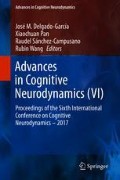Abstract
In the present study, we used the time-varying scalp network analysis method of electroencephalography (EEG) to investigate information flows among different tempos perception in the alpha band. The results showed the network hubs of different tempos existed variously. Only during listening to normal tempo (52 bpm), the strongest out-degree of hubs is distributed in the right hemisphere and the information flow transferred from the left to the right hemisphere. Based on these findings, we proposed that the left hemisphere did not prime the processing until the necessary information had been transferred from the right hemisphere. This study was the first to use time-varying network method based on adaptive directed transfer function (ADTF) to investigate music-related EEG activities and proposed a novel method to reveal the neural mechanisms on music tempo.
Access this chapter
Tax calculation will be finalised at checkout
Purchases are for personal use only
References
Knight, W.E., Rickard, N.S.: Relaxing music prevents stress-induced increases in subjective anxiety, systolic blood pressure, and heart rate in healthy males and females. J. Music. Ther. 38, 254–272 (2001)
Schaefer, R.S., Vlek, R.J., Desain, P.: Music perception and imagery in EEG: alpha band effects of task and stimulus. Int. J. Psychophysiol. 82, 254–259 (2011)
Dalton, B.H., Behm, D.G.: Effects of noise and music on human and task performance: a systematic review. Occup. Ergon. 7, 143–152 (2007)
Ma, W., Lai, Y., Yuan, Y., Wu, D., Yao, D.: Electroencephalogram variations in the α-band during tempo-specific perception. Neuroreport. 23, 125–128 (2012)
Tian, Y., Ma, W., Tian, C., Xu, P., Yao, D.: Brain oscillations and electroencephalography scalp networks during tempo perception. Neurosci. Bull. 29, 731–736 (2013)
Tillmann, B., Janata, P., Bharucha, J.J.: Activation of the inferior frontal cortex in musical priming. Cogn. Brain Res. 999, 145–161 (2003)
Simpson, G.V., Weber, D.L., Dale, C.L., Pantazis, D., Bressler, S.L., Leahy, R.M., Luks, T.L.: Dynamic activation of frontal, parietal, and sensory regions underlying anticipatory visual spatial attention. J. Neurosci. 31, 13880–13889 (2011)
Schmithorst, V.J.: Separate cortical networks involved in music perception: preliminary functional MRI evidence for modularity of music processing. NeuroImages. 25, 444–451 (2005)
Wilke, C., Ding, L., He, B.: Estimation of time-varying connectivity patterns through the use of an adaptive directed transfer function. IEEE Trans. Biomed. Eng. 55, 2557–2564 (2008)
Tian, Y., Yao, D.: Why do we need to use a zero reference? Reference influences on the ERPs of audiovisual effects. Psychophysiology. 50, 1282–1290 (2013)
Yao, D., Wang, L., Arendt-Nielsen, L., Chen, A.C.N.: The effect of reference choices on the spatio-temporal analysis of brain evoked potentials: the use of infinite reference. Comput. Biol. Med. 37, 1529–1538 (2007)
Ding, J.R., An, D., Liao, W., Li, J., Wu, G.R., Xu, Q., Long, Z., Gong, Q., Zhou, D., Sporns, O.: Altered functional and structural connectivity networks in psychogenic non-epileptic seizures. PLoS One. 8, e63850 (2013)
Pietro, M.D., Laganaro, M., Leemann, B., Schnider, A.: Receptive amusia: temporal auditory processing deficit in a professional musician following a left temporo-parietal lesion. Neuropsychologia. 42, 868–877 (2004)
Sammler, D., Koelsch, S., Ball, T., Brandt, A., Elger, C.E., et al.: Overlap of musical and linguistic syntax processing: intracranial ERP evidence. Ann. N. Y. Acad. Sci. 1169, 494–498 (2009)
Poulin-Charronnat, B., Bigand, E., Madurell, F., Peereman, R.: Musical structure modulates semantic priming in vocal music. Cognition. 94, B67 (2005)
Wei, J., Peng, D., Yang, Z., Chan, T., Luo, Y.: The hemispheric difference of semantic processing of Chinese characters in two dimensions as revealed by ERPs. Neuroreport. 12, 3697–3701 (2002)
Stuss, D.T.: Frontal lobes and attention: processes and networks, fractionation and integration. J. Int. Neuropsychol. Soc. 12, 261–271 (2006)
Acknowledgments
This research was supported by the National Natural Science Foundation of China (#61671097); the Chongqing advanced and applied basic research project cstc2015jcyjA10024.
Author information
Authors and Affiliations
Editor information
Editors and Affiliations
Rights and permissions
Copyright information
© 2018 Springer Nature Singapore Pte Ltd.
About this paper
Cite this paper
Xu, W. et al. (2018). Time-Varying Scalp EEG Network Patterns for Music Tempo Perception. In: Delgado-García, J., Pan, X., Sánchez-Campusano, R., Wang, R. (eds) Advances in Cognitive Neurodynamics (VI). Advances in Cognitive Neurodynamics. Springer, Singapore. https://doi.org/10.1007/978-981-10-8854-4_19
Download citation
DOI: https://doi.org/10.1007/978-981-10-8854-4_19
Published:
Publisher Name: Springer, Singapore
Print ISBN: 978-981-10-8853-7
Online ISBN: 978-981-10-8854-4
eBook Packages: Biomedical and Life SciencesBiomedical and Life Sciences (R0)

